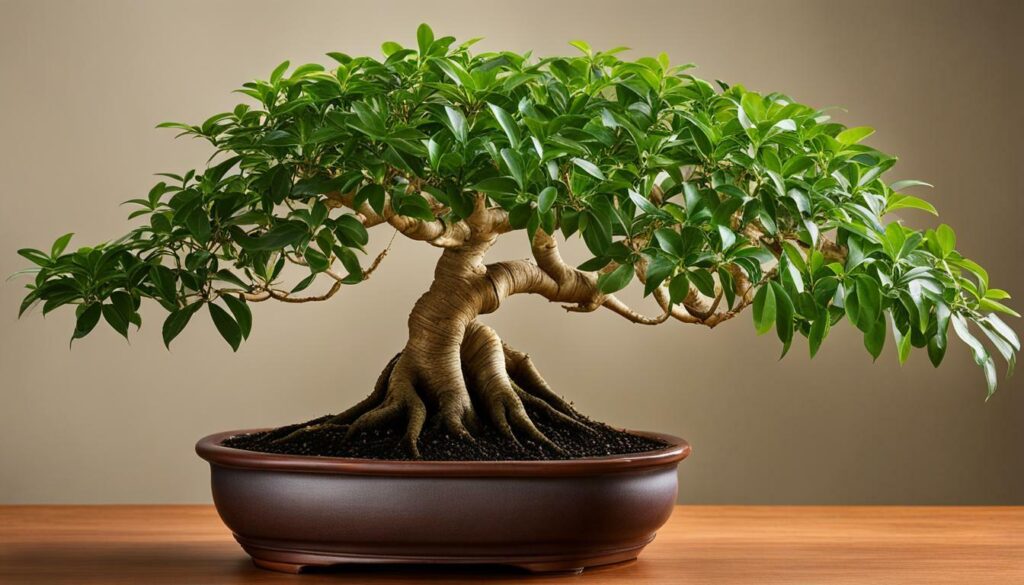Welcome to a comprehensive guide on caring for Ficus ‘Ginseng’ bonsai plants, one of the most stunning and easy-to-grow indoor bonsai plants. Native to Southeast Asia, the Ficus ‘Ginseng’ bonsai is known for its interesting appearance, featuring narrow elevated roots that swell into a potbelly trunk. With proper care and attention, you can enjoy the beauty of this unique plant in your home or office.
- Provide a high humidity environment for your Ficus ‘Ginseng’ bonsai, using an artificial enclosure if necessary.
- Place your bonsai in a location that receives a good amount of light, such as a windowsill or under plant lights.
- Water your bonsai when the soil is slightly dry, avoiding overwatering to prevent fungal issues.
- Regularly wipe the leaves to remove dust and mist the plant for added humidity.
- Fertilize your bonsai with a diluted liquid fertilizer every month and prune it to maintain its shape.
- Utilize wiring and guy wires for training purposes to shape your Ficus ‘Ginseng’ bonsai.
- Propagate your bonsai through stem cuttings and repot it every other year using a suitable bonsai soil mix.
- Be aware of the toxicity of Ficus ‘Ginseng’ bonsai to pets and take precautions.
- Watch out for common pests like spider mites, scale, mealybugs, and aphids, and treat them with appropriate remedies.
- Enjoy the air purification qualities of your Ficus ‘Ginseng’ bonsai and incorporate it into your interior design.
Table of Contents
ToggleUnderstanding Ficus ‘Ginseng’ Bonsai
The Ficus ‘Ginseng’ bonsai, belonging to the Moraceae family, is a fascinating plant native to Southeast Asia that stands out for its intriguing appearance, characterized by narrow elevated roots that form a potbelly trunk. This unique feature gives the bonsai a distinctive and aesthetic appeal, making it a popular choice among bonsai enthusiasts.
This bonsai plant, known as the Ficus retusa in botanical terms, is specifically cultivated for its bonsai form. It can reach a height of 40 to 60 centimeters, and its compact size makes it suitable for indoor cultivation. The Ficus ‘Ginseng’ bonsai is particularly favored for its ease of care and adaptability, making it a suitable choice for beginners in the art of bonsai gardening.
Its native habitat in Southeast Asia provides valuable insight into its preferred growing conditions. Ficus ‘Ginseng’ bonsai plants flourish in warm and humid environments, similar to their natural surroundings. To recreate this high humidity environment, it is recommended to use an artificial enclosure when growing the bonsai indoors. This helps maintain adequate moisture levels around the plant, ensuring its optimum growth and development.
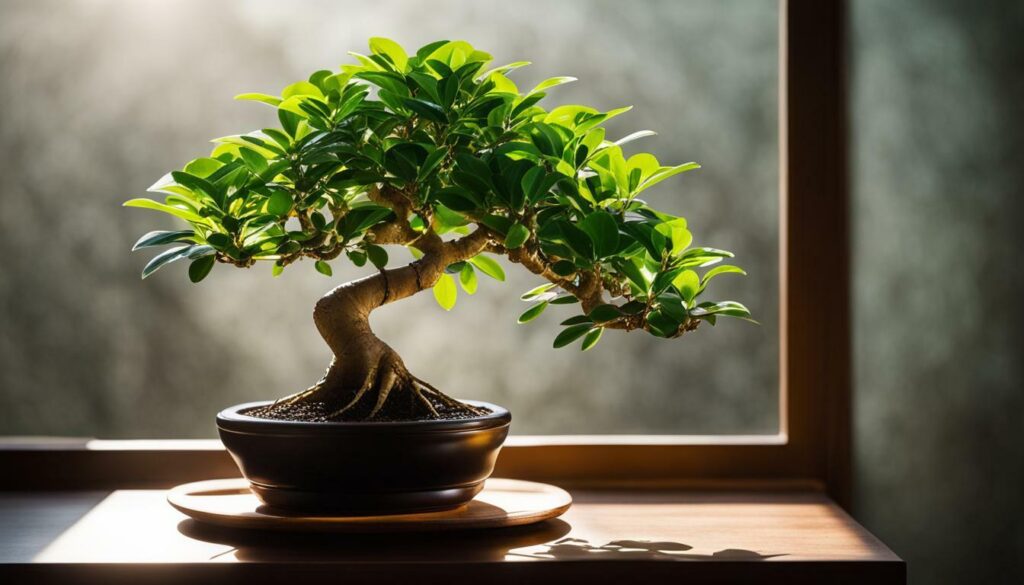
In addition to its unique appearance, the Ficus ‘Ginseng’ bonsai offers several benefits to plant enthusiasts. Its compact size makes it an ideal choice for small living spaces, adding a touch of nature and elegance to any room. Moreover, bonsai plants, including the Ficus ‘Ginseng’, have been found to contribute to air purification by filtering harmful toxins and improving indoor air quality.
| Characteristics | Care Tips |
|---|---|
| Native to | Southeast Asia |
| Appearance | Elevated roots and potbelly trunk |
| Preferred Environment | High humidity |
| Lighting | Good amount of light, near windowsill or with plant lights |
| Watering | When soil is slightly dry, avoid overwatering |
| Fertilization | Monthly with diluted liquid fertilizer |
| Training Techniques | Wiring and guy wires for shaping |
Interesting Appearance and Care Tips
The Ficus ‘Ginseng’ bonsai is undoubtedly an eye-catching addition to any indoor space. Its narrow elevated roots and potbelly trunk bring an artistic touch to its overall aesthetic. To ensure its healthy growth, it is essential to provide the bonsai with a suitable environment that resembles its natural habitat. This includes maintaining high humidity levels, proper lighting conditions, regular watering, and appropriate fertilization.
By following these care tips, you can create an optimal environment for your Ficus ‘Ginseng’ bonsai, allowing it to flourish and thrive as a captivating and resilient plant.
Creating the Optimal Environment
To ensure the well-being of your Ficus ‘Ginseng’ bonsai, it’s crucial to recreate the high humidity environment it thrives in, which can be achieved through the use of artificial enclosures. The plant, native to Southeast Asia, requires a humid climate to flourish, and replicating this environment is essential for its growth and overall health.
An artificial enclosure, such as a terrarium or a greenhouse, can help create the ideal conditions for your Ficus ‘Ginseng’ bonsai. These enclosed spaces trap moisture, allowing the plant to thrive in a high humidity environment. It is important to monitor the humidity levels regularly, ensuring they remain between 50% and 60% for optimal growth.
| Humidity Requirements for Ficus ‘Ginseng’ Bonsai | Humidity Levels |
|---|---|
| Low Humidity | Below 40% |
| Medium Humidity | 40% – 50% |
| High Humidity | 50% – 60% |
| Very High Humidity | Above 60% |
It is essential to place your Ficus ‘Ginseng’ bonsai in a location where it can receive adequate light. The plant requires a good amount of light to support photosynthesis and promote healthy growth. Placing it near a windowsill with indirect sunlight or using plant lights can help meet its lighting requirements.
Remember to monitor the temperature and keep your bonsai away from frost. The Ficus ‘Ginseng’ bonsai is an indoor plant but can be brought outdoors when temperatures consistently reach above 60 degrees Fahrenheit. Exposing it to cold temperatures can cause damage to the plant, hindering its growth and overall survival.
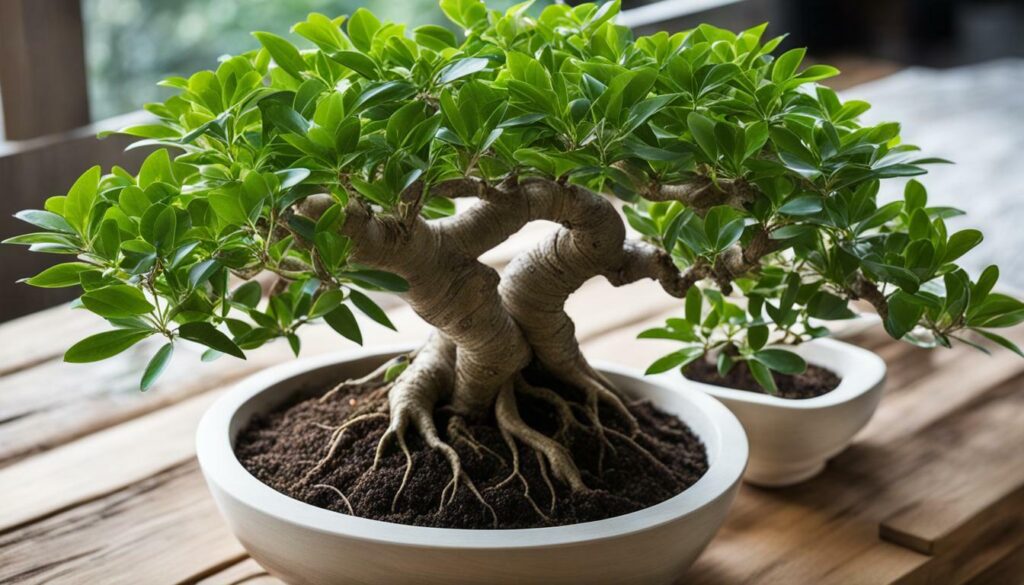
Creating the optimal environment for your Ficus ‘Ginseng’ bonsai is the key to its success. By providing high humidity through the use of artificial enclosures, ensuring adequate lighting, and monitoring temperature conditions, you can promote the healthy growth and longevity of your bonsai plant.
Lighting Requirements
Ficus ‘Ginseng’ bonsai plants require a good amount of light to thrive, and they can be placed on a windowsill or under specialized plant lights. Adequate lighting is essential for the plant’s growth and overall health. Placing the bonsai near a bright window where it can receive indirect sunlight for at least 4-6 hours a day is ideal. A windowsill with east or west-facing exposure is often suitable for providing the right amount of natural light.
If natural light is limited in your space or during the winter months, you can supplement with plant lights. Full-spectrum LED grow lights are a popular choice as they closely mimic the natural light spectrum. Position the lights about 12-18 inches above the bonsai and ensure they are on for 12-16 hours a day. This will provide the necessary light energy for photosynthesis and promote healthy growth.
Remember to monitor the plant closely and adjust the lighting as needed. If the leaves start to yellow or the bonsai becomes leggy, it may be an indication of insufficient light. On the other hand, if the leaves are scorched or show signs of stress, it may be getting too much direct light. Finding the right balance is crucial for the optimal development of your Ficus ‘Ginseng’ bonsai.
| Lighting Tips for Ficus ‘Ginseng’ Bonsai: |
|---|
| 1. Natural Light: Place the bonsai near a bright window with east or west-facing exposure to provide ample indirect sunlight. |
| 2. Plant Lights: Supplement with full-spectrum LED grow lights positioned 12-18 inches above the bonsai for 12-16 hours a day. |
| 3. Monitoring: Observe the bonsai closely and adjust lighting if the leaves show signs of yellowing or scorching. |
By providing the right lighting conditions, you can ensure the healthy growth and vibrant appearance of your Ficus ‘Ginseng’ bonsai plant.
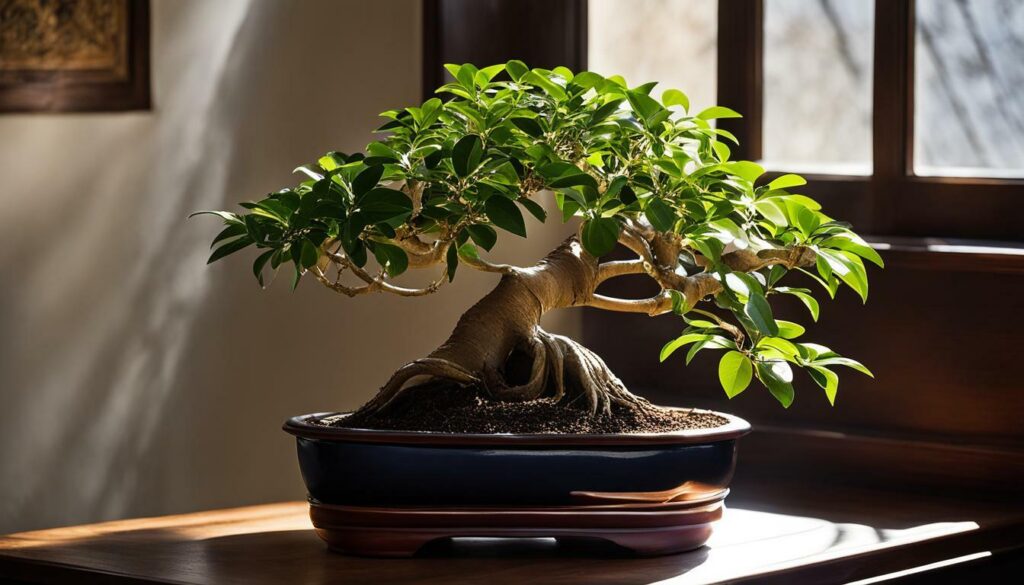
Proper watering is essential for the health of your Ficus ‘Ginseng’ bonsai, ensuring that the soil is slightly dry before watering to avoid overhydration and potential fungal problems. This species prefers well-draining soil, so be sure not to let it sit in excess water. It’s a good idea to check the soil moisture level by touching the top layer with your finger. If it feels dry, it’s time to water. However, do not wait until the soil completely dries out, as that can stress the bonsai.
Regular leaf cleaning is important to keep your Ficus ‘Ginseng’ bonsai plant healthy and vibrant. Use a soft, damp cloth or a gentle spray of water to remove dust from the leaves regularly. This helps ensure that the plant can absorb light and carry out photosynthesis effectively. Additionally, misting the foliage can provide some extra humidity, which is beneficial to the overall well-being of the bonsai.
Protect your Ficus ‘Ginseng’ bonsai from frost, as it is an indoor plant and delicate to low temperatures. If you choose to place it outdoors during the summer months, monitor the weather closely and make sure temperatures consistently remain above 60 degrees Fahrenheit. Sudden drops in temperature can harm the plant and impede its growth.
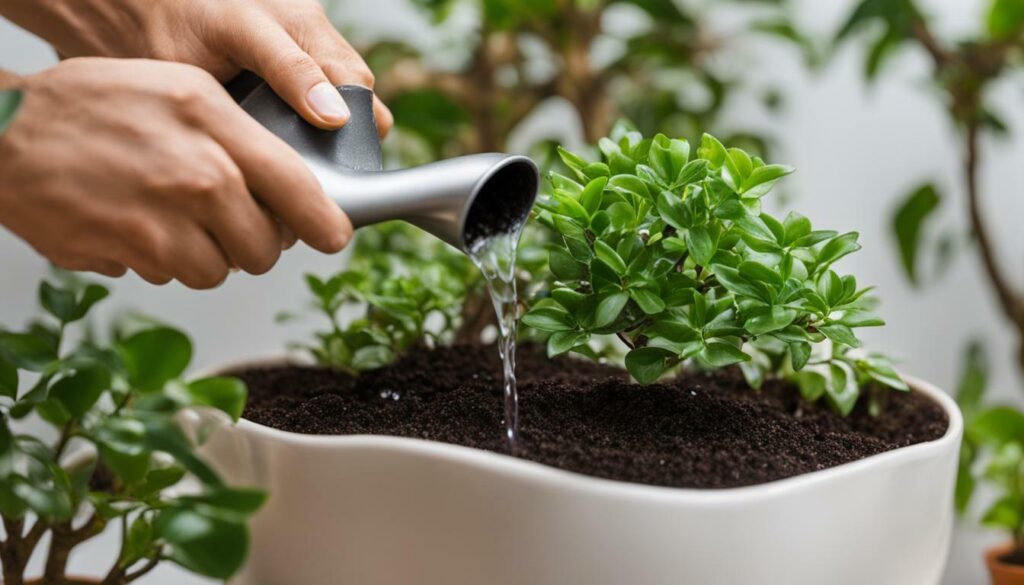
| Watering Tips | Maintenance Tips |
|---|---|
|
|
“Proper watering and leaf maintenance are crucial for the health of your Ficus ‘Ginseng’ bonsai. These practices help prevent overhydration and fungal problems, ensuring your bonsai thrives in optimum conditions.”
Fertilization and Pruning
Regular fertilization with a diluted liquid fertilizer and proper pruning techniques are key to fostering the growth and maintaining the bonsai shape of your Ficus ‘Ginseng’ plant. The right balance of nutrients is essential to keep your bonsai healthy and thriving. Use a liquid fertilizer specifically formulated for bonsai plants and dilute it according to the manufacturer’s instructions. Apply the fertilizer once a month during the growing season, from spring to fall, to provide the necessary nutrients for optimal growth.
When it comes to pruning, it’s important to understand the goals and techniques involved. Pruning helps control the size and shape of your bonsai, as well as promote the development of smaller, more compact leaves. Start by removing any dead, diseased, or damaged branches to improve the overall health of the plant. Next, selectively prune the branches to achieve the desired shape and balance. Trim back any long branches to maintain the bonsai’s proportions. Remember to use sharp, clean pruning shears to make clean cuts and minimize stress on the plant.
Pruning is like giving your bonsai a haircut – it helps maintain its shape and encourages new growth.
Pruning Tips:
- Prune your Ficus ‘Ginseng’ bonsai during the dormant season, usually in late winter or early spring. This allows the plant to recover faster and minimizes stress.
- Trim branches that are growing too straight or upright to create a more natural appearance.
- Remove any branches that cross each other or rub against one another to prevent damage and infection.
- Avoid cutting back more than one-third of the foliage at a time to avoid weakening the plant.
- Regular pruning sessions throughout the year will help maintain the desired shape and size of your bonsai.
Remember that each Ficus ‘Ginseng’ bonsai is unique, so take the time to observe and understand its growth patterns before pruning. With practice, you will develop an eye for shaping your bonsai into a work of art that reflects your personal style and creativity.
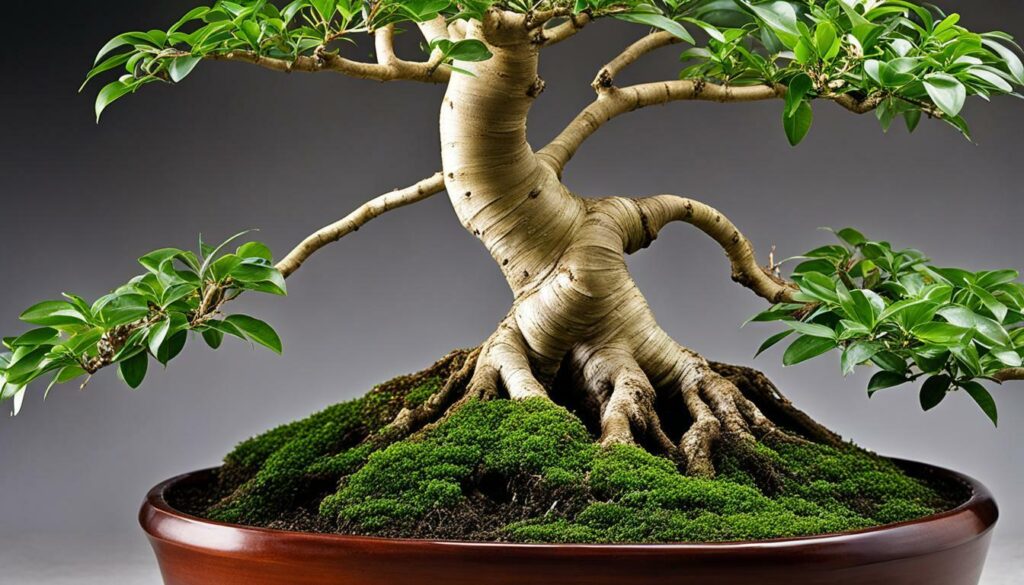
| Fertilizing Tips | Pruning Tips |
|---|---|
| Use a liquid fertilizer specifically formulated for bonsai plants. | Prune during the dormant season to minimize stress. |
| Dilute the fertilizer according to the manufacturer’s instructions. | Trim back long branches to maintain proportions. |
| Apply the fertilizer once a month during the growing season. | Remove dead, diseased, or damaged branches. |
| Monitor the plant’s response to the fertilizer and adjust accordingly. | Prune branches that cross or rub against each other. |
| Observe and understand the plant’s growth patterns before pruning. | Avoid cutting back more than one-third of the foliage at a time. |
Training Techniques
To achieve desired shapes and styles, wiring and the use of guy wires can be employed to train your Ficus ‘Ginseng’ bonsai. Wiring helps in guiding the branches and trunk into specific positions, allowing you to create intricate designs and mimic the natural growth patterns of trees. Guy wires, on the other hand, can be used to gently bend branches over time, encouraging a more horizontal or cascading growth pattern.
When using wiring, it is important to ensure that the wire is not too tight to avoid damaging the bonsai’s delicate branches. Copper or aluminum wire is commonly used due to its flexibility and ability to hold the desired shape. However, it’s crucial to monitor the plant regularly and remove the wire once the branch has set in the desired position.
In addition to wiring and guy wires, pruning also plays a crucial role in training your Ficus ‘Ginseng’ bonsai. Regular pruning helps maintain the desired shape and promotes ramification, resulting in a fuller and more intricate canopy. By selectively removing branches and foliage, you can create a balanced and visually appealing bonsai.
Table: Training Techniques
| Technique | Description |
|---|---|
| Wiring | Guides branches and trunk into specific positions. Use copper or aluminum wire, and remove once the branch has set. |
| Guy Wires | Gently bends branches over time to create horizontal or cascading growth patterns. |
| Pruning | Maintains desired shape and promotes ramification for a fuller canopy. Selectively remove branches and foliage. |
Remember, training your Ficus ‘Ginseng’ bonsai requires patience and careful observation. As you shape and style your bonsai, keep in mind the natural growth patterns of trees and aim to create a harmonious and balanced composition. With time and practice, you can create a stunning bonsai that reflects your personal aesthetic and showcases the beauty of the Ficus ‘Ginseng’ plant.
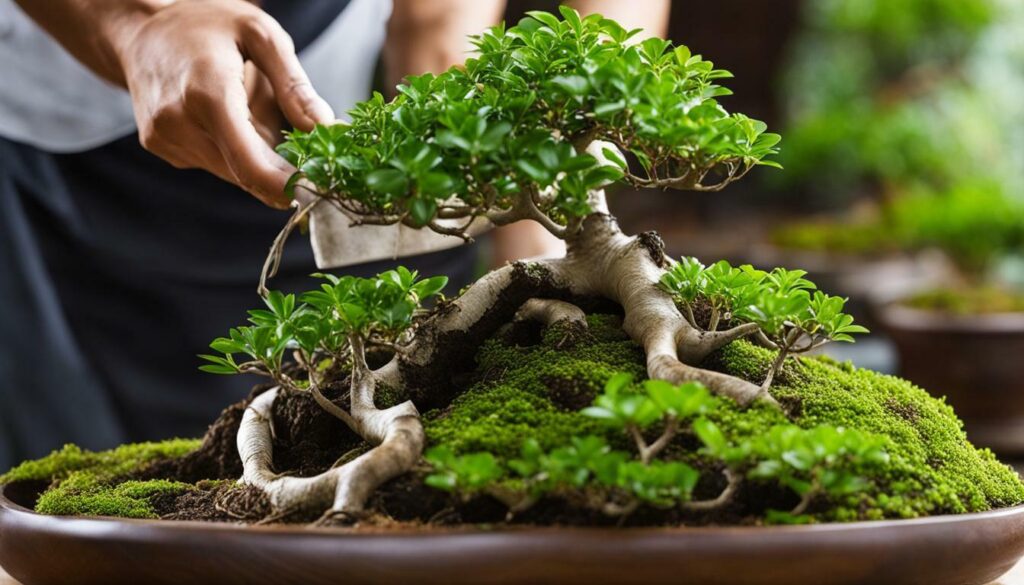
Propagating Ficus ‘Ginseng’ bonsai plants can be done through stem cuttings, and repotting should be performed every other year using a bonsai soil mix. Stem cuttings are a relatively simple method of propagation, allowing you to create new plants from existing ones. To propagate your Ficus ‘Ginseng’ bonsai, follow these steps:
- Select a healthy stem from the parent plant, ideally one that is young and vigorous.
- Use a sharp, clean pair of gardening shears to cut the stem at a 45-degree angle, ensuring the cutting is around 4-6 inches long.
- Remove any leaves from the lower part of the cutting, leaving a few at the top to encourage photosynthesis.
- Dip the cut end of the stem into rooting hormone powder to promote root development.
- Insert the cutting into a small pot filled with a well-draining bonsai soil mix, making sure it is stable and secure.
- Place the pot in a warm and humid environment, ideally under a humidity dome or covered with a plastic bag to retain moisture.
- Water the cutting regularly, making sure the soil remains slightly moist but not overly saturated. Be patient, as it may take several weeks or even months for roots to develop.
- Once the cutting has established a strong root system, you can repot it into a larger container using a bonsai soil mix.
Repotting your Ficus ‘Ginseng’ bonsai is essential for maintaining its health and promoting proper growth. Here’s a step-by-step guide to repotting:
- Carefully remove the bonsai from its current pot, gently loosening the roots using a root rake or chopstick.
- Inspect the roots and trim any that are excessively long or tangled, promoting a more compact root system.
- Choose a new pot that is slightly larger than the current one, ensuring it has drainage holes.
- Place a layer of bonsai soil at the bottom of the pot, ensuring it is level.
- Position the bonsai in the pot, making sure it is centered and at the desired height.
- Fill the remaining space in the pot with a bonsai soil mix, gently firming it around the roots to provide stability.
- Water the newly repotted bonsai thoroughly, allowing the excess water to drain away.
- Place the bonsai in a suitable location, avoiding direct sunlight for a few weeks to minimize stress on the roots.
Remember to monitor the watering needs of your newly propagated or repotted Ficus ‘Ginseng’ bonsai, adjusting as necessary to ensure optimal growth and health.
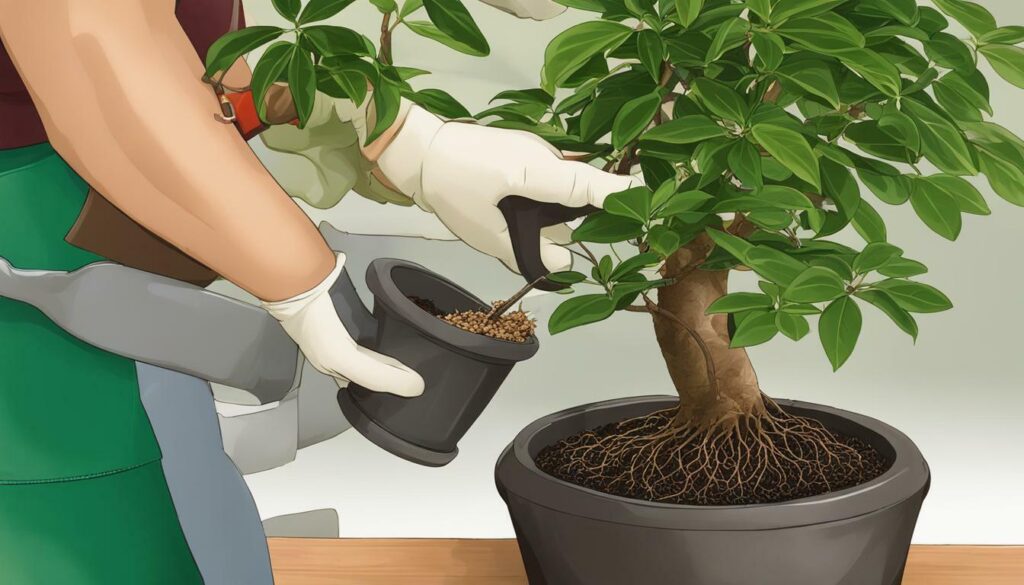
It’s important to keep Ficus ‘Ginseng’ bonsai plants away from pets as they can be toxic. Additionally, common pests like spider mites, scale, mealybugs, and aphids can be treated with neem oil or a mixture of soap and water.
Neem oil is a natural insecticide that can effectively control pests on your Ficus ‘Ginseng’ bonsai. Dilute the neem oil according to the instructions on the packaging and spray it onto the affected parts of the plant. Make sure to cover all surfaces, including the undersides of the leaves, where pests tend to hide. Repeat the application every few days until the pests are eliminated.
If you prefer a more organic approach, you can create a soap and water mixture to combat pests. Mix a few drops of mild liquid soap, such as castile soap or dish soap, with water in a spray bottle. Spray this solution on the affected areas of your bonsai, making sure to reach all the pests. The soap effectively suffocates the insects and disrupts their protective coating. Repeat this process every few days until you see a significant reduction in the pest population.
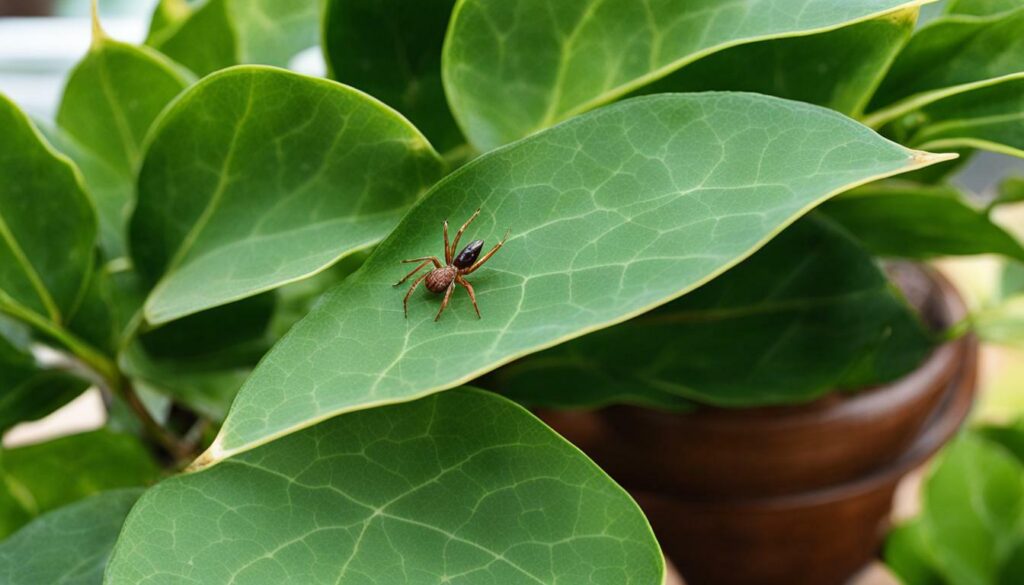
This image shows spider mites, one of the common pests that can affect your Ficus ‘Ginseng’ bonsai. They are tiny insects that feed on the sap of the plant, causing damage to the leaves and stunting growth. Regular inspection of your bonsai and prompt treatment with neem oil or the soap and water mixture can help keep these pests under control.
Table: Common Pests and Their Treatments
| Pest | Treatment |
|---|---|
| Spider mites | Neem oil or soap and water mixture |
| Scale | Neem oil or soap and water mixture |
| Mealybugs | Neem oil or soap and water mixture |
| Aphids | Neem oil or soap and water mixture |
Air Purification and Benefits
Beyond their aesthetic appeal, Ficus ‘Ginseng’ bonsai plants contribute to air purification, providing potential benefits for your indoor environment. These plants have the ability to filter and cleanse the air, removing harmful toxins and pollutants commonly found in our homes and offices. By placing a Ficus ‘Ginseng’ bonsai in your living space, you can improve the overall air quality and create a healthier environment for yourself and your loved ones.
The air purification qualities of Ficus ‘Ginseng’ bonsai plants can be attributed to their lush foliage and efficient respiration process. Through photosynthesis, these plants absorb carbon dioxide and release oxygen, thereby increasing the oxygen levels in the room. Additionally, they absorb various pollutants such as formaldehyde, benzene, and xylene, which are often emitted by household items such as furniture, carpets, and cleaning products.
Studies have shown that exposure to these pollutants can have negative effects on our health, leading to respiratory problems, allergies, and even more serious conditions. By having a Ficus ‘Ginseng’ bonsai in your living space, you can help reduce the concentration of these harmful substances, creating a cleaner and healthier environment. The presence of plants indoors has also been linked to improved mood, reduced stress levels, and increased productivity.
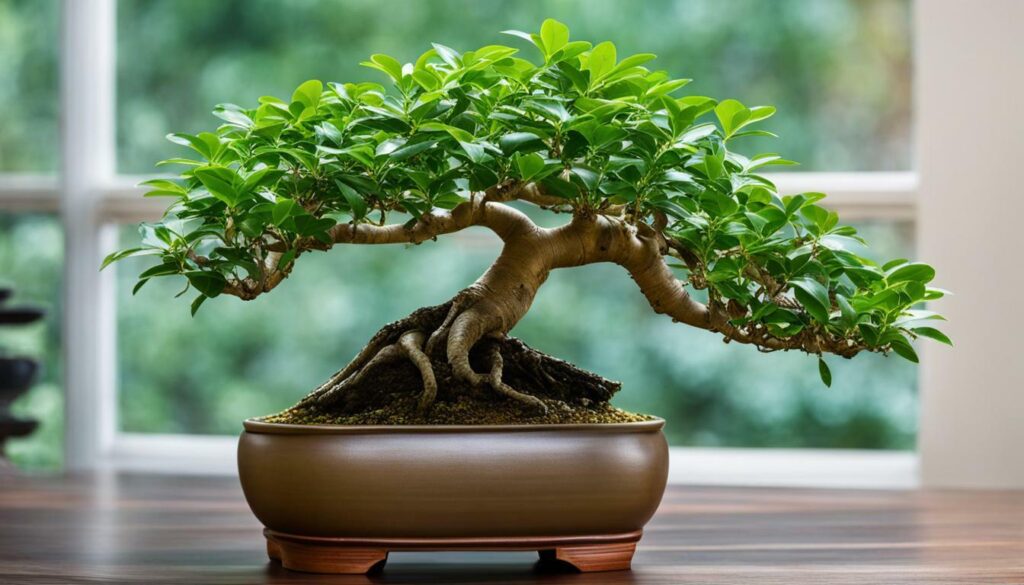
The benefits of indoor plants extend beyond air purification. They bring a touch of nature indoors, creating a calming and serene atmosphere that can enhance your overall well-being. Indoor plants have been shown to reduce stress, improve concentration, and promote a sense of tranquility. Their presence can also help to dampen noise levels, creating a more peaceful environment for relaxation or work.
Furthermore, indoor plants like the Ficus ‘Ginseng’ bonsai can act as natural humidifiers, releasing moisture into the air to combat dryness that can cause respiratory discomfort, dry skin, and even allergies. This can be particularly beneficial during the winter months or in areas with low humidity. By incorporating these plants into your interior design, you can create a more comfortable and enjoyable living space.
In conclusion, Ficus ‘Ginseng’ bonsai plants not only add beauty to your home or office but also have the ability to purify the air and provide a range of potential benefits. By including these plants in your indoor environment, you can enjoy cleaner air, improved well-being, and a more aesthetically pleasing space. Remember to follow the care tips provided earlier in this article to ensure the health and vitality of your Ficus ‘Ginseng’ bonsai.
Styling and Design Ideas
Discover various styling ideas and creative ways to incorporate the beauty of Ficus ‘Ginseng’ bonsai plants into your home or office decor. These unique bonsai plants can add a touch of nature and elegance to any space, creating a peaceful and tranquil atmosphere.
One stylish option is to display your Ficus ‘Ginseng’ bonsai as a centerpiece on a coffee table or side table. Place it on a decorative tray or stand to elevate its presence and create a focal point in the room. The bonsai’s intricate root system and potbelly trunk will surely capture the attention of your guests.
For a more contemporary look, consider grouping several Ficus ‘Ginseng’ bonsai plants together on a shelf or mantel. Play with varying heights and pot sizes to create visual interest. The combination of the bonsai’s unique form and lush green leaves will add a fresh and modern touch to your interior.
If you’re feeling adventurous, try incorporating your Ficus ‘Ginseng’ bonsai into a terrarium or mini garden. Select a glass container and layer it with rocks, moss, and other miniature plants. The bonsai’s elevated roots will make a striking statement within this miniature ecosystem, creating a captivating and enchanting display.
To truly highlight the beauty of your Ficus ‘Ginseng’ bonsai plant, use minimalist and natural decor elements. Opt for clean lines, neutral colors, and organic materials such as wood or stone. This will allow the bonsai to steal the show and become a true centerpiece in your space.
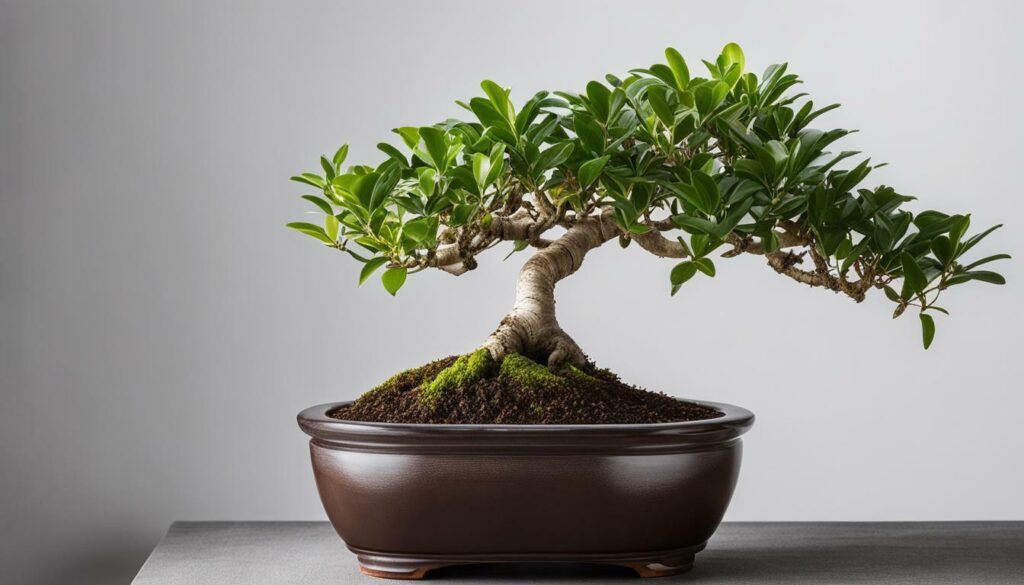
| Styling Ideas for Ficus ‘Ginseng’ Bonsai Plants |
|---|
| Create a centerpiece on a coffee table or side table |
| Group several bonsai plants together for a contemporary look |
| Incorporate the bonsai into a terrarium or mini garden |
| Use minimalist and natural decor elements to highlight the plant |
Quotes:
Adding a Ficus ‘Ginseng’ bonsai plant to my living room completely transformed the space. Its unique appearance and graceful presence bring a sense of Zen and tranquility to my home.
“I love how versatile Ficus ‘Ginseng’ bonsai plants are. They can be styled in so many different ways, making them the perfect addition to any home decor.” – Jane, plant enthusiast
Conclusion
In conclusion, caring for Ficus ‘Ginseng’ bonsai plants is an enjoyable and rewarding experience, with its unique appearance and relatively easy maintenance. By following the provided care tips, you can cultivate a healthy and visually appealing indoor bonsai.
The Ficus ‘Ginseng’ bonsai, belonging to the Moraceae family, is native to Southeast Asia and is known for its interesting appearance with narrow elevated roots that swell into a potbelly trunk. Recreating its natural high humidity environment is essential, and an artificial enclosure can help achieve this.
Proper lighting is crucial for the growth of Ficus ‘Ginseng’ bonsai. Placing it on a windowsill or using plant lights can ensure that it receives a good amount of light. Watering should be done when the soil starts to dry out, while caution should be taken to avoid overwatering, which can lead to fungal issues.
To maintain the bonsai shape, regular pruning is necessary. Additionally, training techniques such as wiring and guy wires can be used to shape the plant according to your preference. Propagation can be done through stem cuttings, and repotting should be performed every other year using a suitable bonsai soil mix.
It is important to note that Ficus ‘Ginseng’ bonsai plants are toxic to pets, so keeping them away from animals is essential for their well-being. Common pests such as spider mites, scale, mealybugs, and aphids can affect the plant, but they can be treated with neem oil or a soap and water mixture.
Overall, caring for a Ficus ‘Ginseng’ bonsai plant requires attention to its specific needs, but with the right care, you can enjoy the beauty of this indoor bonsai and reap its numerous benefits.
FAQ
Is caring for a Ficus ‘Ginseng’ bonsai plant difficult?
No, caring for a Ficus ‘Ginseng’ bonsai plant is relatively easy compared to other bonsai plants.
Where is the Ficus ‘Ginseng’ bonsai plant native to?
The Ficus ‘Ginseng’ bonsai plant is native to Southeast Asia.
What is unique about the appearance of the Ficus ‘Ginseng’ bonsai plant?
The Ficus ‘Ginseng’ bonsai plant has narrow elevated roots that swell into a potbelly trunk, giving it an interesting appearance.
How can I recreate the high humidity environment that the Ficus ‘Ginseng’ bonsai plant thrives in?
It is recommended to use an artificial enclosure to create the high humidity environment that the Ficus ‘Ginseng’ bonsai plant needs.
Where should I place my Ficus ‘Ginseng’ bonsai plant for optimal light?
The Ficus ‘Ginseng’ bonsai plant requires a good amount of light and can be placed on a windowsill or under plant lights.
How often should I water my Ficus ‘Ginseng’ bonsai plant?
Watering should be done whenever the soil gets slightly dry, but overwatering should be avoided to prevent fungal issues.
How should I clean the leaves of my Ficus ‘Ginseng’ bonsai plant?
The leaves should be wiped off regularly to remove dust, and the plant can be misted for added humidity.
Can I keep my Ficus ‘Ginseng’ bonsai plant outdoors?
The Ficus ‘Ginseng’ bonsai plant is an indoor plant and should be kept away from frost. It can be brought outside in temperatures consistently above 60 degrees Fahrenheit.
How often should I fertilize my Ficus ‘Ginseng’ bonsai plant?
Fertilizing with a diluted liquid fertilizer every month is recommended for your Ficus ‘Ginseng’ bonsai plant.
Is pruning necessary for my Ficus ‘Ginseng’ bonsai plant?
Yes, pruning is necessary to maintain the bonsai shape of your Ficus ‘Ginseng’ plant. Wiring and guy wires can also be used for training purposes.
How can I propagate my Ficus ‘Ginseng’ bonsai plant?
Propagation is possible through stem cuttings.
How often should I repot my Ficus ‘Ginseng’ bonsai plant?
Repotting should be done every other year using a bonsai soil mix.
Is the Ficus ‘Ginseng’ bonsai plant toxic to pets?
Yes, the Ficus ‘Ginseng’ bonsai plant is toxic to pets and should be kept away from them.
What are common pests that can affect my Ficus ‘Ginseng’ bonsai plant?
Common pests that can affect your Ficus ‘Ginseng’ bonsai plant include spider mites, scale, mealybugs, and aphids. They can be treated with neem oil or a soap and water mixture.
